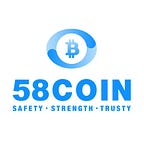Taker Or Maker? Simple In Theory, Difficult To Distinguish In Actual Application!
On July 2, a user showed his screenshot of the transaction and questioned about the maker-taker fee, why did “maker” become “taker”?
Speaking of Maker and Taker, a senior investor may be able to distinguish the concept, however, when actually being charged the fee, he/she may not clear about the role. Investors of 58COIN always have the question like “I’m a maker, why the fee is charged according to taker standard?”
Then how to distinguish between Maker and Taker? Some people say it’s easy, Maker provides liquidity and Taker takes away liquidity. The theory is easy to understand, but if they are applied in the actual transaction, it’s very difficult to differentiate!
What Are Makers And Takers?
Different from other investment markets, a Maker Taker is a cryptocurrency exchange model that involves two distinct fees that any investor on the trade is subjected to — maker and taker fees.
Maker: A market maker places the orders with prices that are different from the current market price. Usually, a market maker will try and sell for higher price and buy for lower price. Market maker’s trades are not filled immediately, they usually appear in the order book and are executed when a market taker finds maker’s price satisfactory.
Taker: A market taker is a participant of the market, that is agreeing with the currently listed prices on the order book and wishes to fill his trade immediately. If the highest selling price and the lowest buying price is okay for you and you settle a trade, you become a market taker.
Taker Or Maker, Determined By The Status When An Order Is Executed!
Instead of judging by the state when you place an order, Taker or Maker is determined according to the status when an order is executed. This explains the above doubts from the investors.
The above user’s question can be concluded to “Why there is a gap between Maker fee and Taker fee?”. Let’s take a look at this user’s order price, when he placed a closing order, the opening price of BTCUSDT contract was $10,313.16 and the highest price was $10,315.00 at 10:06 (UTC +8) on July 2, however, his closing price was $10,310, which means that the user filled the trade immediately after he placed the order. His real role was a Taker, not the Maker as he mentioned. Therefore, the fee was charged according to the taker standard.
Make Judgment By Limit Oder, Market Order, And Market
When an investor places an order to buy or sell a contract, there are two fundamental execution options: place the order “at market” or “at limit.” Market orders are transactions meant to execute as quickly as possible at the present or market price. Conversely, a limit order sets the maximum or minimum price at which you are willing to buy or sell, transactions are to be executed at the limited price or within the limited price range. Therefore, when you place a limit order, the price entered actually represents a price range.
1) It is sure that all investors that place market orders are Takers, and it’s impossible to converse the role.
2) For a limit order, when it enters the matching process and cannot be filled immediately with an existing order, then it will enter the order book and waits for the execution, in such case, the investor’s identity is Maker.
Please be noted that due to the rapid changes of the cryptocurrency market, especially when the market price rises or falls sharply, a large number of orders will enter the order book. Therefore, in the case of a large increase in orders, the investor’s identity may change.
3) When a limit order is placed, if there is no matching order in the order book, the investor’s identity will be marked as Maker; however, if there is a matching order at the time when the investor places a limit order, and the transaction is executed, then the investor’s identity will be changed to Taker.
Therefore, when a user places an opening or closing order and enters a limited transaction price, it does not mean that your identity is confirmed as Maker, the status at the time of final transaction is the only factor that judges.
Conclusions:
Taker: 1) Market order; 2) Limit order, and is immediately filled with the matching order in the market.
Maker: Limit order, but is not immediately filled with the matching order, and enters the order book.
Maker Changes to Taker: When the order is placed, there is no matching order in the market. At this time, the investor’s identity is Maker, but then a matching order instantaneously appears and the transaction is executed. At this point, the investor’s identity is converted from Maker to Taker.
Website: https://www.58ex.com/
Facebook: https://www.facebook.com/coin.58COIN
Twitter: https://twitter.com/58_coin
Telegram: https://t.me/official58
